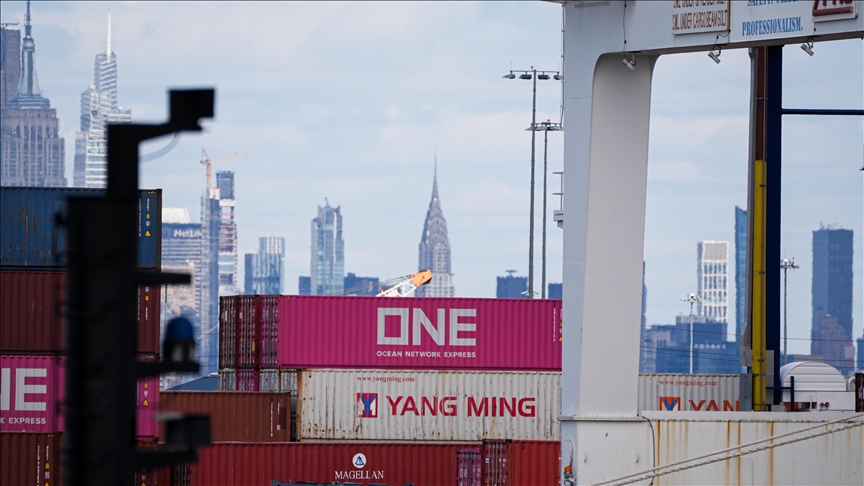ANALYSIS - Is Trump’s tariff war reshaping global economy?
To boost production, domestic market, lessen foreign dependence, come out on top against economic rivals, Trump’s ‘America First’ policies play key role in global trade, as he leverages tariffs as bargaining chip to make other fall in line

WASHINGTON / NEW YORK / BERLIN
President Donald Trump triggered a global trade war in a bid to bring production back to the US, undermine efforts of rivals and rebalance what he claims to be unfair and out-of-balance trade.
All this while leveraging tariffs as an economic tool and bargaining chip for negotiations and threats.
For years, Trump has been suggesting the US should impose tariffs on countries to revitalize the economy and for American goods to be produced in domestic plants, as well as to defend US national security interests by reducing foreign dependence on countries.
Trump’s tariff plan is centered around creating and maintaining jobs in the country and boosting industrial capacity with competitive, domestically-made goods, while raising wages with investments, as well as devaluing the US dollar and slowing imports to bring exports up.
Stephen Miran, chair of the Council of Economic Advisers, blamed the high US dollar exchange rate on the imbalance in global trade in a 41-page report prepared last November. The report suggests that tariffs are the most appropriate tools to use against the high exchange rate.
The high demand for US foreign exchange reserves is what leads to the dollar’s overvaluation. American banks and insurers invest reserves in Treasury bonds and Washington finances its operations via the bonds.
The federal government’s debt currently stands at $36 trillion and the ever-rising demand for bonds keeps the dollar’s value high, but Trump reportedly wants a change.
The change would begin by excluding foreign creditors from the market via tariffs and stopping military protection to countries that do not fall in line with Washington’s requests.
The US Sovereign Wealth Fund (SWF) has been deemed as a game-changing development in policy toward that goal.
The SWF, established Feb. 3, confirmed the Trump administration’s strategy to take action against trade imbalances by targeting capital flows and the overvaluation of the dollar.
Trump’s protectionism stems from his ‘America First’ approach
Trump’s economic policies are centered on a protectionist approach, shaped by his “America First” rhetoric to reposition the US in the global economy and prioritize national interests.
The president claimed time and again that globalization is hurting the US economy by leading to job cuts, especially in the manufacturing sector, which in turn boosts foreign dependence.
Tariffs come into play in his bid to pursue a strategy to enhance the domestic market against foreign competition. Tariffs against major exporters like China are a testament to Trump’s strategy.
Trump’s advocacy for a nationalist, or isolationist, and product-oriented model against globalization can be considered a criticism of free trade agreements like NAFTA -- as the president argued they harm American workers.
Through bilateral agreements and tariffs, Trump is proposing a new trade order to strengthen US economic independence and enhance self-sufficiency in strategic sectors. But at what cost?
Trump’s use of tariffs reflects his pragmatic and competitive approach, derived from his experience as a businessman, as he leverages them, not only as economic measures, but as tools to apply pressure and force the targeted nations to make compromises.
Trump described “tariff” as “the most beautiful word in the dictionary” and he said he would deliver on his promise to target countries that have been “unfairly” treating the US to rebalance trade with major trading partners, such as China, Japan, and the EU.
He imposed 25% tariffs on Canada and Mexico and 10% on China due to alleged fentanyl and undocumented migrant inflows into the US. Trump later raised the penalties to 20% on China and also announced indiscriminate steel and aluminum tariffs of 25%.
Washington’s sweeping reciprocal tariffs were announced April 2. Trump said they would range from 10% to 50%, taking into account the tariffs and non-tariff barriers imposed by other countries to reciprocate against those policies.
Trump plans to tariff pharmaceuticals, chips, and lumber, citing claims that the US is not being treated fairly.
What can the US gain from tariffing trade partners?
The US has been suffering from substantial trade deficits for quite some time. The food trade deficit reached more than $1.2 trillion last year.
Tariffs raise the price of imported goods, which is a strategy Trump is employing to reduce imports, so the US foreign trade deficit narrows.
When imports become more expensive, the expectation is that goods made in the US will increase and consumers will opt for domestically-produced alternatives. At the same time, domestic production and consumers choosing to buy American-made products will contribute to economic growth and employment.
This tariff strategy is believed to inevitably lead to price increases passed onto the consumer and inflation in import-dependent sectors.
Retaliatory tariffs by targeted countries can also disrupt exports and supply chains, which cast doubt on the long-term benefits of Trump’s tariffs.
Promises to bring back American industry
Globalization and the exploitation of cheap labor have led to factory closures in the Midwest, the heart of US manufacturing, and tariffs are aimed at revitalizing the American industry. White House data shows that the US share in global production fell from 28.4% in 2001 to 17.4% in 2023.
Job creation in the manufacturing sector is expected to be limited despite the many policies to prioritize domestic production in the auto, steel and machinery industries due to the rise of ever-developing automation to replace workers.
Meanwhile, rising raw material costs can weaken the competitiveness of American manufacturers. Trump stated that lower taxes in the US but high tariffs on products made outside of the US would boost production at home.
His statements on protecting American jobs, bringing the US industry back and threatening rivals won the hearts of working-class voters in particular, as he appeared to be on the side of the people, especially in battleground states.
Trump used tariffs to demonstrate his nationalism in the presidential race but a tangible economic result to show positive outcomes have yet to come to the fore.
Tariffs could also trigger a backlash from voters due to job losses and price increases, especially after Trump ran on lowering the prices of essential goods like eggs and milk, which resonated with the median voter.
Attempts to limit China’s economic influence
China’s affordable products and corporate subsidies pose a threat to US tech and economic dominance.
Trump is using tariffs to hamper Beijing’s efforts to rise in the global economy, and sending a message to allies that trade with the US is safer, despite reciprocal tariffs.
The US’ potential close economic alliance with Japan and Europe could limit China’s influence, while a China-led economic bloc against the US could upset the global trade balance.
What does Trump really like?
Trump also deems tariffs as a source to generate federal revenues, as they will be paid and transferred to the Treasury Department, which is expected to accumulate a significant sum. He made astronomical estimates of how much money tariffs would generate, saying they would “make America rich again.”
Assuming last year’s imports remain unchanged, even a 10% base tariff on each country would generate only an additional $300 billion. The Trump administration estimates $600 billion to $700 billion per year.
Tariffs, in reality, are intended to finance tax cuts for the rich and corporations. Trump plans permanent individual tax cuts, such as eliminating taxes on tips.
Meanwhile, Trump wants to create an environment where countries come to his footsteps to negotiate. He imposed different tariff rates for each country to prompt them to plead with the White House and negotiate with him directly.
He hopes his shock and awe tactics will force the US power and prestige to rise, as he believes American economic and technological prowess will deter retaliation from friend and foe alike, and instead, pressure them to comply with his priorities.
Trump is aware that he holds great power over dozens of countries, if not the entire world, as the man at the helm of the most significant and influential country on the planet. The president likes wielding US potential as a weapon to tell others that trade rules and security guarantees are exclusively in his will to give, take or change.








